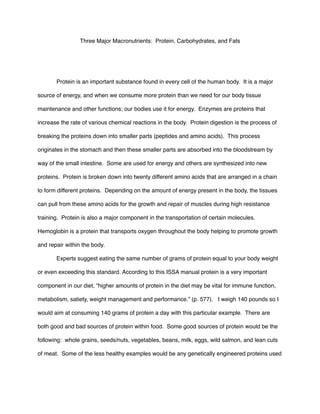
Three Major Macronutrients- Protein Carbohydrates Fats
- 1. Three Major Macronutrients: Protein, Carbohydrates, and Fats Protein is an important substance found in every cell of the human body. It is a major source of energy, and when we consume more protein than we need for our body tissue maintenance and other functions; our bodies use it for energy. Enzymes are proteins that increase the rate of various chemical reactions in the body. Protein digestion is the process of breaking the proteins down into smaller parts (peptides and amino acids). This process originates in the stomach and then these smaller parts are absorbed into the bloodstream by way of the small intestine. Some are used for energy and others are synthesized into new proteins. Protein is broken down into twenty different amino acids that are arranged in a chain to form different proteins. Depending on the amount of energy present in the body, the tissues can pull from these amino acids for the growth and repair of muscles during high resistance training. Protein is also a major component in the transportation of certain molecules. Hemoglobin is a protein that transports oxygen throughout the body helping to promote growth and repair within the body. Experts suggest eating the same number of grams of protein equal to your body weight or even exceeding this standard. According to this ISSA manual protein is a very important component in our diet, “higher amounts of protein in the diet may be vital for immune function, metabolism, satiety, weight management and performance.” (p. 577). I weigh 140 pounds so I would aim at consuming 140 grams of protein a day with this particular example. There are both good and bad sources of protein within food. Some good sources of protein would be the following: whole grains, seeds/nuts, vegetables, beans, milk, eggs, wild salmon, and lean cuts of meat. Some of the less healthy examples would be any genetically engineered proteins used
- 2. in various types of food. Anything that was created in a lab or chemically altered you should steer clear of. Carbohydrates main purpose is to give us the energy needed for metabolism. Some carbohydrates are used immediately for our cells while others are stored in our liver in the form of glycogen. There are also some that turn into fat and are stored in our fat cells as well. Our body needs carbohydrates in order to burn fat. A breakdown of these carbohydrates is necessary to metabolize fat. Carbohydrates help with the gastro-intestinal function of the body and they help make our food more flavorful. There are good and bad sources of carbohydrates, and it is important to be able to recognize the difference between the two. Some examples of good carbohydrates are the following: whole grain products such as rice, pasta, bread, oats, buckwheat, rye, and barley. These foods have plenty of fiber and vitamins/minerals, and are very beneficial to your health. They cause a slower change, gradually, to take place in blood sugar levels and help you feel full after eating them. Fruits, vegetables, and legumes (beans, peas, lentils) are loaded with vitamins, nutrients, and carbohydrates. We should consume approximately two cups of fruit and two and a half cups of vegetables daily. Fat is a concentrated source of energy. When carbohydrates are depleted in your body, it turns to fat as a back-up source for burning calories. Fat provides energy, absorbs certain nutrients, and helps maintain your core body temperature. We need to consume fat daily to support these functions. There are good and bad sources of fat out there. Good fats protect our heart and keep our body healthy, while bad fats do the opposite by increasing the risk of various diseases or damaging the heart. Good fats are usually the monounsaturated or polyunsaturated fats, and they help to stabilize cholesterol levels and lower your overall risk of heart disease. These fats can be found in the following: vegetable oils, nuts, avocados, and
- 3. salmon or tuna. Bad fats, or saturated and trans fats raise your cholesterol. These fats can be found in the following: meats, sea food, dairy, bakery items, and processed junk food. According to Dr. Frederick C. Hatfield, “ Our bodies have two simple priorities: 1) Break the carbon oxygen bonds contained in our carbohydrates, proteins, and fats 2) Use the energy released to regenerate adenosine-phosphate bonds forming ATP” (p. 531). Dr. Hatfield also states the following: Most energy we require for short duration exercise comes from nutrients that have been stored in our bodies from 1) hepotocytes (liver) 2) myocytes (muscle cells) and 3) adipocytes (fat cells) for some time. This means that most energy we have today is from the stored nutrients of yesterday, the day before, and the day before that ( p.529). With all that being said, you can now see why it is so very important to be aware of what we are putting into our mouths on a daily basis. I will use this knowledge to help educate my clients, in the simplest way possible, about the importance of protein, carbohydrates, and fats in our bodies and the specific roles and responsibilities each one has in order for our bodies to operate in the highest functional capacity. Hatfield, Frederick C. PhD, Fitness: The Complete Guide: Official Text for ISSA Certified Fitness Trainer Course Edition 9.0, p. 548-558
